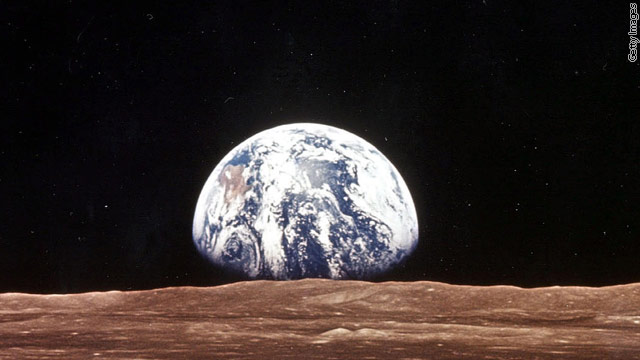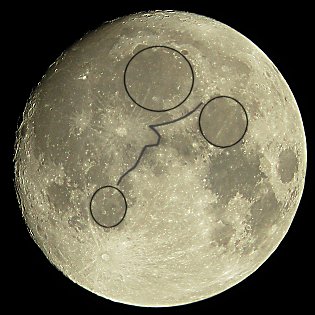It's very late at night. So I thought I'd find a few facts about the moon.

Gallileo spacecraft took this photo of the Moon, not me.
(Photo from NASA)

The Earth, as seen from the Moon's surface. This was taken shortly before Neil Armstrong and Buzz Aldrin got out of Apollo 11 to go walk on the Moon. These kinds of photos always give me the strangest kind of vertigo.
(Photo by Getty, sourced from CNN)

The Moon on March 19, 2011, when it was at its closest point to Earth. Scientists refer to this as the Super Perigee Moon. It's seen here looking over the shoulder of the Lincoln Memorial in Washington, D.C.
(Photo by Bill Ingalls at NASA)

Here's a recent composite of lots of photos taken by NASA's Lunar Reconnaissance Orbiter Camera, of the far side of the moon.
(Photo from NASA)

I always wondered what exactly people thought was the man in the moon. This is one person's outline. Is this where you see the man in the moon, too?
(Image by David Haworth)


Gallileo spacecraft took this photo of the Moon, not me.
(Photo from NASA)
- The Moon is made of the Earth. Scientists are pretty sure that the Moon was formed about 4.5 billion years ago, when a giant something-or-other about the size of Mars crashed into the Earth. The collision sent a giant spray of rock and earth and basically hunks of the Earth's crust flying into the air. All the debris, smaller than the Earth, fell into orbit around our planet. Gradually, after about 100 million years, the debris coalesced into what we now know as the Moon. So you could say the Moon is very upper-crust.
- We're about the same age. Even though the Moon was formed out of the Earth's crust, scientists have estimated that the Moon and the Earth about both about 4.56 billion years old.
- But the Moon is a lot skinnier. The moon has about 1/80th the mass that Earth does. But don't worry. The Moon might be skinnier, but we're a lot more popular.

The Earth, as seen from the Moon's surface. This was taken shortly before Neil Armstrong and Buzz Aldrin got out of Apollo 11 to go walk on the Moon. These kinds of photos always give me the strangest kind of vertigo.
(Photo by Getty, sourced from CNN)
- The Moon wants more space. It's slowly moving farther away from the Earth, at a rate of about 4 centimeters per year. But don't worry, it's not going to break up with us completely. In about 50 billion years from now, it will stop drifting away and settle into a new orbit. By that point it will be far enough away that instead of taking roughly 27.3 days to make it around the Earth, it will take 47 days. I wonder if we'll adjust our calendars by then.
- The Moon's official name is "the Moon." Nobody knew for a long time that other planets had their own satellites. So when they called ours the Moon, they thought it was the only one. When they found out there were other moons orbiting other planets, it was too late to call the Moon Murgatroyd or Mephistopheles or Millicent or anything else but Moon. So they refer to the other moons as "a moon" with a lower case m, or else they give those other moons specific names like Io.

The Moon on March 19, 2011, when it was at its closest point to Earth. Scientists refer to this as the Super Perigee Moon. It's seen here looking over the shoulder of the Lincoln Memorial in Washington, D.C.
(Photo by Bill Ingalls at NASA)
- The Moon shows us only its face. Back in the good old days when the Moon was first formed, it used to rotate around the Earth and show off all its sides. But over time its rotation slowed down untiil it became "tidally locked" with Earth. Another way to describe this is to say that it rotates on its axis at the same rate of speed as it takes to go around the Earth. In other words, it's stuck on showing us one side. This is how we got things like Pink Floyd's Dark Side of the Moon. Because it only shows us one side, no one had any idea what was over there on the other side until 1959 when a Soviet spacecraft went over there and took pictures. Thanks to lots more spacecraft and space cameras, NASA will soon be releasing new topographic map of the moon -- all the way around.

Here's a recent composite of lots of photos taken by NASA's Lunar Reconnaissance Orbiter Camera, of the far side of the moon.
(Photo from NASA)
- The hot side stays hot and the cold side stays cold. Well, that's true for about two weeks at a time. Because the takes 27.3 days to complete one rotation, its days are a lot longer. One full day, from sunrise to sunrise, takes about 27.3 days. This means that for two weeks, the same side of the moon is facing the sun. Because there's barely any atmosphere around the Moon -- or at least, not like what we have -- the sun's light and heat go straight to the Moon's surface. The bright side can get up to 243 degrees F in that two-week period. Meanwhile, the dark side can get as cold as -272 degrees F in that same time period.
- The Man in the Moon is really geography. What we think looks like a face is the highlands, which look brighter, and the large seas of once-upon-a-time-volcanic-lava, which are darker. This lunar geography was formed by all sorts of asteroids and other space-things slamming into the Moon and leaving scars all over the place.

I always wondered what exactly people thought was the man in the moon. This is one person's outline. Is this where you see the man in the moon, too?
(Image by David Haworth)

I like to think of the Moon as friends with all of us. Here, it's friends with the giraffes.
(Photo from desktopart wallpaper)
Other Daily Apple entries about the Moon:
Blue Moons
Full Moons, Orange and Otherwise
Origins of the Earth and Moon
Lunacy and the Full Moon
(Photo from desktopart wallpaper)
Other Daily Apple entries about the Moon:
Blue Moons
Full Moons, Orange and Otherwise
Origins of the Earth and Moon
Lunacy and the Full Moon
Sources
Fraser Cain, Interesting Facts about the Moon, Universe Today, October 24, 2008
NASA, The Far Side of the Moon -- And All the Way Around, March 11, 2011
The Earth's History, How old is the Earth?
National Geographic News, Moon Facts, July 16, 2004
NASA, Solar System Exploration, Earth's Moon
Fraser Cain, Interesting Facts about the Moon, Universe Today, October 24, 2008
NASA, The Far Side of the Moon -- And All the Way Around, March 11, 2011
The Earth's History, How old is the Earth?
National Geographic News, Moon Facts, July 16, 2004
NASA, Solar System Exploration, Earth's Moon
No comments:
Post a Comment
If you're a spammer, there's no point posting a comment. It will automatically get filtered out or deleted. Comments from real people, however, are always very welcome!